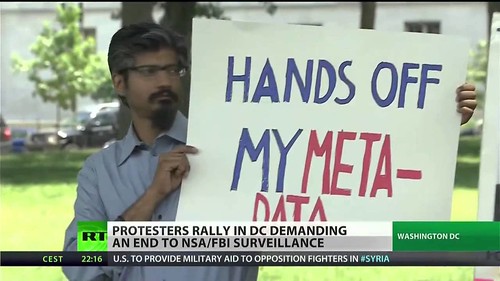
Civil liberties activists demonstrated across the United States on July 4, 2013 in opposition to broad National Security Agency spying. Edward Snowden is being scapegoated for the revelations., a photo by Pan-African News Wire File Photos on Flickr.
U.S. spy agency used some Americans' data to map their behavior: NYT
7:50pm EDT
WASHINGTON (Reuters) - The New York Times reported on Saturday that the National Security Agency, the main U.S. government surveillance organization, had since 2010 used data it gathered to map some Americans' "social connections that can identify their associates, their locations at certain times, their traveling companions and other personal information."
In the latest revelation of the activities of the NSA, which have prompted concern about previously unknown intrusion into Americans' privacy in the name of protecting against terrorist and other foreign attacks, the newspaper quoted documents provided by Edward Snowden, the former NSA contractor who fled to Russia earlier this year.
It said the documents showed that "the spy agency began allowing the analysis of phone call and email logs in November 2010 to examine Americans' networks of associations for foreign intelligence purposes after NSA officials lifted restrictions on the practice."
The policy shift was intended to help the agency "discover and track" connections between intelligence targets overseas and people in the United States, according to an NSA memorandum from January 2011, the Times said.
It said the NSA was authorized to conduct "large-scale graph analysis on very large sets of communications metadata without having to check foreignness" of every email address, phone number or other identifier, the document said. Because of concerns about infringing on the privacy of American citizens, the computer analysis of such data had previously been permitted only for foreigners.
The agency could augment the communications data with material from public, commercial and other sources, including bank codes, insurance information, Facebook profiles, passenger manifests, voter registration rolls and GPS location information, as well as property records and unspecified tax data, according to the documents, the paper said.
It said NSA officials declined to say how many Americans had been affected and said the documents did not describe the result of the scrutiny, which it said "links phone numbers and emails in a 'contact chain' tied directly or indirectly to a person or organization overseas that is of foreign intelligence interest."
COURT RULING
Earlier this week, leaders of the U.S. Senate Intelligence Committee said they were working on legislation that would tighten oversight of federal electronic eavesdropping programs. Support for such changes has been growing since Snowden leaked information in June that the government collects far more Internet and telephone data than previously known.
The Times said that an NSA spokeswoman, asked about the analyses of Americans' data, said, "All data queries must include a foreign intelligence justification, period." It quoted her as saying: "All of NSA's work has a foreign intelligence purpose."
She said the policy change disclosed in the latest revelations was based on a 1979 Supreme Court ruling that Americans could have no expectation of privacy about what numbers they had called.
The Times quoted her as saying that, based on that ruling, the Justice Department and the Pentagon decided that it was permissible to create contact chains using Americans' "metadata," which includes the timing, location and other details of calls and emails, but not their content. The agency is not required to seek warrants for the analyses from the Foreign Intelligence Surveillance Court.
NSA officials declined to identify which phone and email databases were used to create the social network diagrams, and the documents provided by Snowden do not specify them, the paper said.
It said the NSA did say that the large database of Americans' domestic phone call records, which was revealed by Snowden in June and caused alarm in Washington, was excluded.
The Times said that while concerns in the United States since Snowden's revelations had largely focused on the scope of the agency's collection of the private data of Americans and the potential for abuse, the new documents provided a rare window into what the agency actually did with the information it gathers.
(Reporting by David Storey; Editing by Paul Simao)
No comments:
Post a Comment